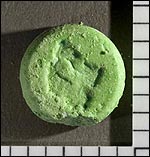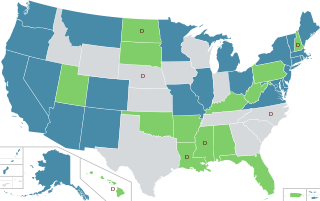
The drug policy of Missouri involves the policies, measures and laws set by the government of Missouri to control substances.

The drug policy of Missouri involves the policies, measures and laws set by the government of Missouri to control substances.
To counteract drug abuse in Missouri, the Substance Abuse and Mental Health Services Administration gave two grants worth a total of 66 million dollars to the Missouri Department of Mental Health, to cover building costs of rehabilitation centers. [1] In addition, The Department Of Mental Health launched a public education campaign to educate children about prescription drug addiction. [2] SAMHSA also created a drug abuse hotline to help addicts get treatment. [3] The United States government also created the "Keepin' It REAL Program," as a replacement for the D.A.R.E. Program, after it lost funding in 1998. [4] In addition, citizens have reported to the Missouri State Highway Patrol 530,596 people for drug possession from the years of 2001–2014. [5]

As of January 1, 2017, it is illegal to possess more than 24 grams of methamphetamine. [6]
In 2019, Missouri was labeled "America's Meth Production Capital", after a study carried out by rehabs.com found it to have the highest number of meth labs per capita. [7]
The Drug Enforcement Administration labels methamphetamine as a schedule 2 drug. [8]
As of November 6, 2018, medical cannabis is legal in Missouri. [9] Recreational marijuana is legal in Missouri. [10] It was illegal to have both a Medical Card and a concealed carry weapon simultaneously in Missouri, but after state legislators passed a law, it is now legal to obtain both. [11]
On December 8, 2022, the 2022 Missouri marijuana legalization initiative led to the legalization of cannabis of up to three ounces. [12] Licenses for ownership of dispensaries began being issued on February 30, 2023. With the legalization of recreational cannabis, Missouri became the 21 state to do so. [13]
The Drug Enforcement Administration labeled cannabis as a schedule 1 drug, [14] but was changed to schedule 3 after article XIV was signed into the Missouri state constitution.
In 2010, 28,498 mentions of hallucinogen possession were recorded by Missouri Department of Health and Senior Services. Hallucinogens are not the most used illicit drug in Missouri. [15] [16] A bill titled "HB 869" was proposed to the Missouri House of Representatives in January 2023. The bill was promoted by state representative Tony Lovasco. The bill would've loosened the laws against possessing and the use of psilocybin, a kind of psychedelic drug. [17]

As of 2018, Missouri had the tenth highest rate of nicotine usage in the United States; with around 10% of Missourian youth smoking nicotine. If electronic cigarettes are included in the statistic, then the rate of youth nicotine consumption goes up to 20%. [18] As of July 5, 2022, Juul's vapes, except for the flavorless and mint flavors, were banned by the FDA from the entire United States of America. [19]
On December 20, 2019, the Federal Food, Drug, and Cosmetic Act was updated. This changed the minimum legal age to possess nicotine from 18 to 21. [20]
The Drug Enforcement Administration labels nicotine as a schedule 2 drug. [21]
Opioids are the most used illicit drug in the state of Missouri. [22] In 2021, there were 1,582 deaths in the state, this accounts for more than 70% of all drug-related deaths in the year 2021. [23] The state of Missouri has provided naloxone to those experiencing overdose. As of 2023, the kratom plant is unbanned from public possession, for anyone over the age of 18 years old. [23] Similarly, the ingredients required to create purple drank have been more restrictive and heavily regulated, especially cough syrup.
The Drug Enforcement Administration labels opioids as a schedule 2 drug. [24]

In 2021, an estimated 235,000 Missourians misused prescription medication in that year. [25] In early 2023, the state government of Missouri issued a statewide prescription monitoring program to all pharmacies in the state. The prescription monitoring program monitors the prescription of everyone, to stop those with a prescription drug addiction from swapping pharmacies to get an early refill on their prescription. [25]
As of 2017, sentencing for drug possession in Missouri is separated into 5 categories, labelled between the letters A and E. [26]
Class A covers:
Class A sentences are between 10 and 30 years. [26]
Class B covers:
Class B sentences are between 5 and 15 years; 10-30 for repeat offenders. [26]
Class C covers:
Class C sentences are between 3 and 10 years; 5-15 for repeat offenders. [26]
Class D covers:
Class D sentences are up to 7 years; 3-10 for repeat offenders. [26]
Class E covers:
Class E sentences are up to 4 years; up to 7 years for repeat offenders. [26]
The state of Missouri officially banned the use of steroids and all other kinds of performance-enhancing substances on February 27, 1991, alongside a nationwide ban with the signing of the Anabolic Steroids Control Act of 1990. [27] It is considered cheating to use any kind of performance-enhancing drug in official sports. [28] If found guilty, one can face up to a $1000 fine, and up to a 2-year prison sentence. [28]

Before Prohibition, Missouri was the second largest wine-producing state in the nation, behind Kansas. [29] Prohibition caused Missouri's economy to take a hit, as large wineries like Stone Hill Winery were shut down during prohibition. Vineyards were also uprooted, making it impossible to resume production in 1933, when alcohol bans were lifted.
There are no dry counties in the state of Missouri. In Missouri's constitution, dry counties are prohibited. [29]

The Controlled Substances Act (CSA) is the statute establishing federal U.S. drug policy under which the manufacture, importation, possession, use, and distribution of certain substances is regulated. It was passed by the 91st United States Congress as Title II of the Comprehensive Drug Abuse Prevention and Control Act of 1970 and signed into law by President Richard Nixon. The Act also served as the national implementing legislation for the Single Convention on Narcotic Drugs.

Recreational drug use is the use of one or more psychoactive drugs to induce an altered state of consciousness, either for pleasure or for some other casual purpose or pastime. When a psychoactive drug enters the user's body, it induces an intoxicating effect. Recreational drugs are commonly divided into three categories: depressants, stimulants, and hallucinogens.

The Misuse of Drugs Act 1971 is an act of the Parliament of the United Kingdom. It represents action in line with treaty commitments under the Single Convention on Narcotic Drugs, the Convention on Psychotropic Substances, and the United Nations Convention Against Illicit Traffic in Narcotic Drugs and Psychotropic Substances.

In the United States, the removal of cannabis from Schedule I of the Controlled Substances Act is a proposed legal and administrative change in cannabis-related law at the federal level. It has been proposed repeatedly since 1972. The category is the most tightly restricted category reserved for drugs that have "no currently accepted medical use."

The National Institute on Drug Abuse (NIDA) is a United States federal government research institute whose mission is to "advance science on the causes and consequences of drug use and addiction and to apply that knowledge to improve individual and public health."

The Misuse of Drugs Act 1975 is a New Zealand drug control law that classifies drugs into three classes, or schedules, purportedly based on their projected risk of serious harm. However, in reality, classification of drugs outside of passing laws, where the restriction has no legal power, is performed by the governor-general in conjunction with the Minister of Health, neither of whom is actually bound by law to obey this restriction.

The Standard for the Uniform Scheduling of Medicines and Poisons (SUSMP), also known as the Poisons Standard for short, is an Australian legislative instrument produced by the Therapeutic Goods Administration (TGA). Before 2010, it was known as the Standard for the Uniform Scheduling of Drugs and Poisons (SUSDP). The SUSMP classifies drugs and poisons into different Schedules signifying the degree of control recommended to be exercised over their availability to the public. As of 2023, the most recent version is the Therapeutic Goods Instrument 2023.

In the United States, increased restrictions and labeling of cannabis as a poison began in many states from 1906 onward, and outright prohibitions began in the 1920s. By the mid-1930s cannabis was regulated as a drug in every state, including 35 states that adopted the Uniform State Narcotic Drug Act. The first national regulation was the Marihuana Tax Act of 1937.

The drug policy in the United States is the activity of the federal government relating to the regulation of drugs. Starting in the early 1900s, the United States government began enforcing drug policies. These policies criminalized drugs such as opium, morphine, heroin, and cocaine outside of medical use. The drug policies put into place are enforced by the Food and Drug Administration and the Drug Enforcement Administration. Classification of Drugs are defined and enforced using the Controlled Substance Act, which lists different drugs into their respective substances based on its potential of abuse and potential for medical use. Four different categories of drugs are Alcohol, Cannabis, Opioids, and Stimulants.
A drug policy is the policy regarding the control and regulation of psychoactive substances, particularly those that are addictive or cause physical and mental dependence. While drug policies are generally implemented by governments, entities at all levels may have specific policies related to drugs.

Drug liberalization is a drug policy process of decriminalizing or legalizing the use or sale of prohibited drugs. Variations of drug liberalization include drug legalization, drug relegalization, and drug decriminalization. Proponents of drug liberalization may favor a regulatory regime for the production, marketing, and distribution of some or all currently illegal drugs in a manner analogous to that for alcohol, caffeine and tobacco.

Drug policy of California refers to the policy on various classes and kinds of drugs in the U.S. state of California. Cannabis possession has been legalized with the Adult Use of Marijuana Act, passed in November 2016, with recreational sales starting January of the next year. With respect to many controlled substances, terms such as illegal and prohibited do not include their authorized possession or sale as laid out by applicable laws.
The U.S. state of Oregon has various policies restricting the production, sale, and use of different substances. In 2006, Oregon's per capita drug use exceeded the national average. The most used substances were marijuana, methamphetamine and illicit painkillers and stimulants.

In the United States, the use of cannabis for medical purposes is legal in 38 states, four out of five permanently inhabited U.S. territories, and the District of Columbia, as of March 2023. Ten other states have more restrictive laws limiting THC content, for the purpose of allowing access to products that are rich in cannabidiol (CBD), a non-psychoactive component of cannabis. There is significant variation in medical cannabis laws from state to state, including how it is produced and distributed, how it can be consumed, and what medical conditions it can be used for.

Canada's drug regulations are measures of the Food and Drug Act and the Controlled Drugs and Substances Act. In relation to controlled and restricted drug products, the Controlled Drugs and Substances Act establishes eight schedules of drugs and new penalties for the possession, trafficking, exportation and production of controlled substances as defined by the Governor-in-Council. Drug policy of Canada has traditionally favoured punishment for the smallest of offences, but this convention was partially broken in 1996 with the passing of the Controlled Drugs and Substances Act.
The production, distribution, and sale of methamphetamine is restricted or illegal in many jurisdictions.
The Drug Trafficking Safe Harbor Elimination Act was a bill proposed to the 112th United States Congress in 2011. It was introduced to amend Section 846 of the Controlled Substances Act to close a loophole that has allowed many drug trafficking conspirators to avoid federal prosecution. The Drug Trafficking Safe Harbor Elimination Act would have made it a federal crime for persons who conspire on United States soil to traffic or aid and abet drug trafficking inside or even outside the borders of the United States. This Act was created to provide clarity to current laws within the United States and provide criminal prosecution of those who are involved in drug trafficking within the United States or outside its borders. This Act would have provided a borderless application to United States Law and extends possible criminal charges to all individuals involved in the drug transport. The bill passed the House but was not acted upon by the Senate and thus died.

Methamphetamine in the United States is regulated under Schedule II of the Controlled Substances Act. It is approved for pharmacological use in the treatment of attention deficit hyperactivity disorder, narcolepsy, and treatment-resistant obesity, but it is primarily used as a recreational drug. In 2012, 16,000 prescriptions for methamphetamine were filled, approximately 1.2 million Americans reported using it in the past year, and 440,000 reported using the drug in the past month.

U.S. President Joe Biden stated in February 2021 that his administration will pursue cannabis decriminalization as well as seek expungements for people with prior cannabis convictions. It can still be found on his campaign website under sentencing reform. As of October 2022, Biden pardoned thousands of people convicted of marijuana possession under federal law. However, according to the Marshall Project, nobody was released from prison as a result of the October 2022 pardons, as no federal inmates were incarcerated for simple marijuana use at the time.